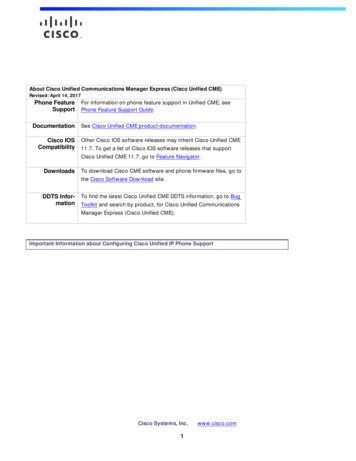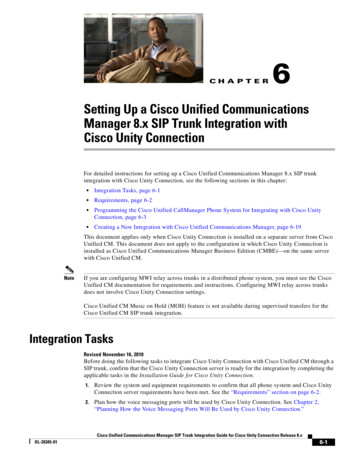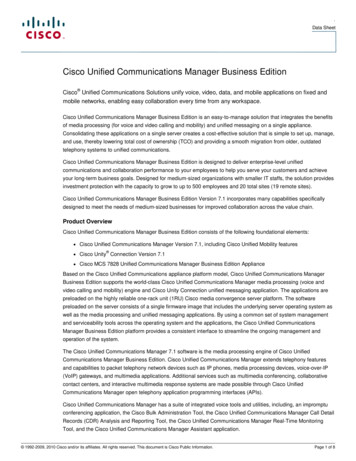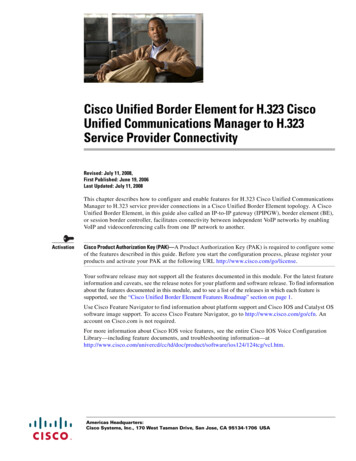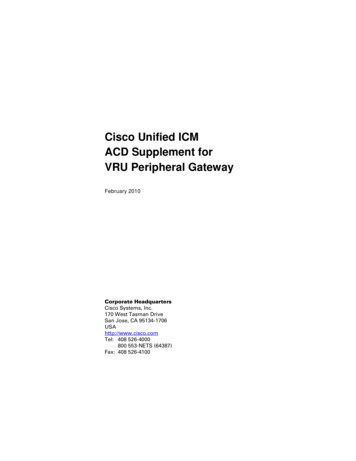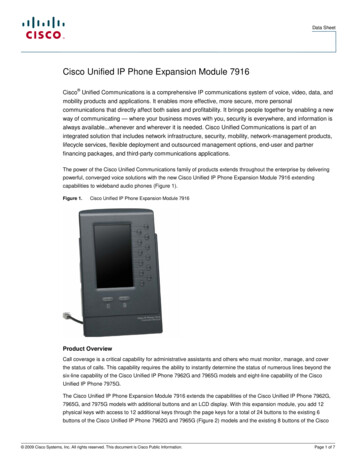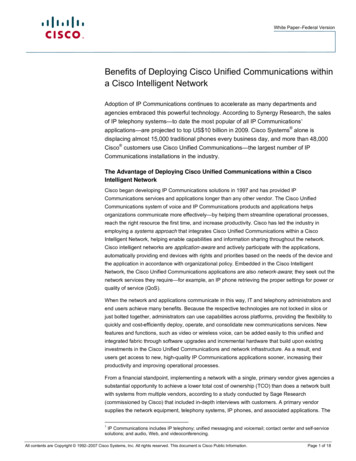
Transcription
White Paper–Federal VersionBenefits of Deploying Cisco Unified Communications withina Cisco Intelligent NetworkAdoption of IP Communications continues to accelerate as many departments andagencies embraced this powerful technology. According to Synergy Research, the salesof IP telephony systems—to date the most popular of all IP Communications1applications—are projected to top US 10 billion in 2009. Cisco Systems alone isdisplacing almost 15,000 traditional phones every business day, and more than 48,000Cisco customers use Cisco Unified Communications—the largest number of IPCommunications installations in the industry.The Advantage of Deploying Cisco Unified Communications within a CiscoIntelligent NetworkCisco began developing IP Communications solutions in 1997 and has provided IPCommunications services and applications longer than any other vendor. The Cisco UnifiedCommunications system of voice and IP Communications products and applications helpsorganizations communicate more effectively—by helping them streamline operational processes,reach the right resource the first time, and increase productivity. Cisco has led the industry inemploying a systems approach that integrates Cisco Unified Communications within a CiscoIntelligent Network, helping enable capabilities and information sharing throughout the network.Cisco intelligent networks are application-aware and actively participate with the applications,automatically providing end devices with rights and priorities based on the needs of the device andthe application in accordance with organizational policy. Embedded in the Cisco IntelligentNetwork, the Cisco Unified Communications applications are also network-aware; they seek out thenetwork services they require—for example, an IP phone retrieving the proper settings for power orquality of service (QoS).When the network and applications communicate in this way, IT and telephony administrators andend users achieve many benefits. Because the respective technologies are not locked in silos orjust bolted together, administrators can use capabilities across platforms, providing the flexibility toquickly and cost-efficiently deploy, operate, and consolidate new communications services. Newfeatures and functions, such as video or wireless voice, can be added easily to this unified andintegrated fabric through software upgrades and incremental hardware that build upon existinginvestments in the Cisco Unified Communications and network infrastructure. As a result, endusers get access to new, high-quality IP Communications applications sooner, increasing theirproductivity and improving operational processes.From a financial standpoint, implementing a network with a single, primary vendor gives agencies asubstantial opportunity to achieve a lower total cost of ownership (TCO) than does a network builtwith systems from multiple vendors, according to a study conducted by Sage Research(commissioned by Cisco) that included in-depth interviews with customers. A primary vendorsupplies the network equipment, telephony systems, IP phones, and associated applications. The1IP Communications includes IP telephony; unified messaging and voicemail; contact center and self-servicesolutions; and audio, Web, and videoconferencing.All contents are Copyright 1992–2007 Cisco Systems, Inc. All rights reserved. This document is Cisco Public Information.Page 1 of 18
White Paper–Federal Versionfinancial benefit found by this study is compelling: the network cost of ownership per endpoint in aprimary-vendor network is 26 percent lower than that of a multivendor network. Savings are spreadequally across all areas, including network deployment and maintenance, network performanceimprovements, and benefits for IT and end users. Sage Research also found that organizations thatuse a single, primary vendor for IP telephony have a 43-percent lower network cost of ownershipthan those that use multiple vendors. Further, Gartner’s analysis of Cisco services reported that“Cisco’s service and support continues to be an asset and a major source of differentiation betweenthe company and the rest of the enterprise market.”How Cisco Does ItA Closer Look at the Benefits of the Cisco SolutionCustomers enjoy significant business and technical benefits by combining Cisco UnifiedCommunications with a Cisco Intelligent Network, as summarized in Figure 1.Figure 1.The Benefits of Deploying Cisco Unified Communications within a Cisco Intelligent NetworkThe following outlines how Cisco switching, routing, and wireless solutions uniquely deliver thesebenefits with Cisco Unified Communications.Deployment Benefits Faster, more cost-efficient IP phone moves, adds, and changes Automatically configure Cisco Catalyst switches for voice Efficiently power Cisco Unified IP Phones Automatically configure Cisco Unified IP Phones Ensure optimum voice quality across the WAN Secure Unified Communications everywhere—from the endpoints to the networkinfrastructure Always-available voiceAll contents are Copyright 1992–2007 Cisco Systems, Inc. All rights reserved. This document is Cisco Public Information.Page 2 of 18
White Paper–Federal VersionOperational Benefits Faster resolution of voice issues Rapid detection and notification of voice anomalies Centralized troubleshooting—avoid onsite visits Common view of the network for voice and data teams Reduced 911 costs and dispatching errors Greater accuracy of voice configuration changesConsolidation Benefits Consolidated Cisco Unified Contact Center voice recording Scalable wireless voice services Services integration, which simplifies the network Video as a simple addition Integrated services and supportDeployment BenefitsFaster, More Cost-Efficient IP Phone Moves, Adds, and ChangesThe simplicity with which Cisco customers can make phone moves, adds, and changes and theresulting administrative cost savings is one example of the power of Cisco Unified Communicationsintegration. In large companies, about 25 percent of their personnel move each year (a commonindustry standard for moves, adds, and changes) and the Yankee Group estimates that it costscompanies up to US 150 per move, add, or change. This operational expense can be minimizedwith Cisco Unified Communications products and Cisco Catalyst switching solutions.After a Cisco Unified IP Phone is plugged into a wall jack, the connected Cisco Catalyst switch portcan be automatically configured for voice and then it automatically provides the properconfigurations and optimal power to the Cisco Unified IP Phone. Other vendors that offer only thevoice components, or partner with infrastructure vendors, lack this type of integration. As a result,each time a phone is moved or added to the network, IT personnel must be notified so they canmanually reconfigure the switch ports—significantly increasing administrative and support costs asIP telephony deployments continue to grow.How It WorksAutomatically Configure Cisco Catalyst Switches for VoiceWhen a Cisco Unified IP Phone is plugged into a wall jack, the connected Cisco Catalyst switch (forexample, the Cisco Catalyst 6500, Catalyst 4500, Catalyst 3750, Catalyst 3560, and CatalystExpress 500) detects that the link is now “up” and issues a Cisco Discovery Protocol exchangewith the phone to get device information. Also, Cisco Catalyst switches will begin supporting LinkLayer Discovery Protocol-Media Endpoint Devices (LLDP-MED) in 2007 as an additional method toattain this information. If this information indicates that the endpoint is an IP Phone, then the switchport can be automatically configured for voice using the Cisco IOS Software Embedded EventManager (EEM) feature in the Cisco Catalyst 6500.All contents are Copyright 1992–2007 Cisco Systems, Inc. All rights reserved. This document is Cisco Public Information.Page 3 of 18
White Paper–Federal VersionCisco EEM is a powerful and flexible automation technology that helps administrators to set custompolicies that control what actions a switch should dynamically take when particular events occur.At a later time, if users decide to unplug their phone and move it to a new location, then removingthe voice configuration on the previous switch port helps to strengthen security. This removal canbe done dynamically when the phone is unplugged, helping reduce administrative costs. Thisdynamic switch configuration change is once again enabled by the Cisco EEM feature.In addition to the EEM-based method of automatically configuring switch ports for voice, Cisco alsooffers administrators who use Cisco Network Assistant, the GUI-based network managementapplication for small and medium-sized agency networks, another method to quickly configureswitches for voice. When a Cisco Unified IP Phone is plugged in, the Smartports Advisor feature onthe Cisco Catalyst switch can automatically send a dialogue box prompt to the Cisco NetworkAssistant management interface. The administrator then has the option to apply the appropriateSmartports voice macro (described later in the paper) to that switch port, simplifying the CiscoCatalyst switch configuration for voice.Additional Cisco technologies, such as Smartports macros or AutoQoS macros, can be used tosimplify and increase the accuracy of voice configurations on Cisco Catalyst switches. CiscoSmartports macros include a suite of voice-critical macros and templates that can be applied to anyCisco Catalyst switch port (for example, the Cisco Catalyst 6500, Catalyst 4500, Catalyst 3750,Catalyst 3560, and Catalyst Express 500) to make configuration much simpler. These macros arebased on Cisco best practices and experience with running IP Communications in the network.With a standard or customized Cisco Smartports macro, an administrator no longer has to log intoeach network switch port and configure all the parameters for ports that support IPCommunications, including such parameters as voice VLANs, port security, Dynamic HostConfiguration Protocol (DHCP) snooping, and Spanning Tree PortFast. Instead, the company canautomatically upload a single template to a switch that includes all the proper settings. CiscoSmartports macros do not function in third-party or multivendor network environments, translatinginto loss of a powerful cost- and time-saving tool. Administrators can also develop customSmartports macros that take advantage of other time-savings Cisco technologies, such asAutoQoS.Cisco developed AutoQoS macros in response to customer demand for a faster way to deploy QoSconfigurations, which may have to be set on hundreds or thousands of switch and router ports toassure optimal voice and video quality, regardless of network congestion. This powerful feature ofCisco IOS Software automatically handles a range of tasks traditionally done manually, includingclassifying applications, generating policies, configuring the proper QoS configurations, monitoringand reporting to test QoS effectiveness, and enforcing service-level consistency. After CiscoAutoQoS evaluates a network environment and determines policy, with only one command itconfigures the port on an access switch to prioritize voice traffic—and it still offers the flexibility toadjust and tailor QoS settings to customer-specific requirements. It also automatically monitorsQoS settings and makes this information available in reports, with notification of abnormal events.In network environments that lack Cisco AutoQoS, applying QoS involves many repetitive stepsthat must be applied individually to each switch in the network. Although Cisco AutoQoS enhancesthe operation of voice traffic from any source, it has been specifically optimized and tested only ona Cisco end-to-end infrastructure. Cisco has completed extensive benchmarking encompassingthousands of hours to deliver the highest compatibility of Cisco AutoQoS across Cisco switches,routers, and IP phones.All contents are Copyright 1992–2007 Cisco Systems, Inc. All rights reserved. This document is Cisco Public Information.Page 4 of 18
White Paper–Federal VersionEfficiently Power IP PhonesIP Communications devices such as IP phones require power to operate, but getting power from awall socket is not always a viable option—especially when phones scale into the thousands. In2000, Cisco was the first company to introduce inline power (evolving to Power over Ethernet[PoE], the IEEE 802.3af standard) that enabled the LAN switching infrastructure to provide powerover an Ethernet cable to a powered device. Cisco offers Cisco Unified IP phones and CiscoCatalyst switches (for example, the Cisco Catalyst 6500, Catalyst 4500, Catalyst 3750, Catalyst3560, and Catalyst Express 500) that support both the 802.3af standard and Cisco prestandardPoE (inline power) for additional flexibility.Beyond the basic PoE standard, Cisco provides additional levels of power control with CiscoIntelligent Power Management (IPM) and massive PoE scalability that enables high-density PoEdeployments. Like other unique features available with Cisco Unified Communications in a Ciscoinfrastructure, Cisco PoE provides customers with significant power-consumption savings topowered devices (for example, IP phones, wireless access points, and IP video surveillancecameras) that use Cisco Discovery Protocol to negotiate power. Whereas the IEEE standardspecifies that 802.3af power should be provisioned in large increments of wattage such as 7 or 15watts of power to each device regardless of power need, the Cisco IPM allows administrators toprovision power based on the power the device actually needs (for example, some Class 3 devicesneed only 10W instead of the default 15.4W value indicated in the 802.3af standard). This poweroptimization, combined with the scalable power supplies offered on modular Cisco Catalystswitches, helps customers maximize PoE port density thereby minimizing the number of requiredCisco Catalyst switches and the cost of electricity, backup UPS, and battery power systems.To further optimize power consumption and to protect the switch against misbehaving endpoints,administrators can set hard limits on the amount of power that is delivered to each switch port,using the latest Cisco Catalyst 6500 PoE daughter card. By limiting the power on a per-port basis,this card can safely override IEEE standards-based power classification, and the switch shuts offthe port when it exceeds the configured power limit, protecting the switch from over-current andover-subscribing the power supply.Automatically Configure Cisco Unified IP PhonesWhen the Cisco Catalyst switch has the proper voice configuration and is delivering the appropriateamount of power to the Cisco Unified IP Phone, it can use the Cisco Discovery Protocol toautomatically set certain configurations on the Cisco Unified IP Phone and other devices attachedto the phone (for example, a PC). The Cisco Catalyst switch indicates to the Cisco Unified IPPhone the voice VLAN ID2 it should use and the class-of-service (CoS) value it should apply to thevoice traffic. The Cisco Catalyst switch, using the Extended Trust feature, can also indicate whatCoS value the Cisco Unified IP Phone should apply to traffic coming from devices attached to thephone. A CoS value of 5 indicates high priority and is usually reserved for voice; call signaling isgiven a value of 3; and best-effort traffic is marked with a 0. So, even if a rogue PC tries to raise itsCoS value to 5, the Cisco Unified IP Phone resets the CoS value on the incoming packets of thatPC to the Extended Trust CoS value communicated by the Cisco Catalyst switch. As a result, voicequality through the switch is not adversely affected by that rogue PC.2Voice VLANs can be thought of as individual channels within a physical network. They are used to isolatetraffic that is highly sensitive to network conditions such as voice so that this traffic can be assigned preferentialtreatment through QoS settings.All contents are Copyright 1992–2007 Cisco Systems, Inc. All rights reserved. This document is Cisco Public Information.Page 5 of 18
White Paper–Federal VersionEnsure Optimum Voice Quality Across the WANCisco has also taken a systems approach of integrating Cisco Unified Communications within aCisco Intelligent Network to help ensure optimum voice quality across the WAN. Not only do Ciscointegrated services routers support standards-based QoS, but they also exchange information withCisco Unified Communications Manager to enable network-aware Call Admission Control (CAC)with QoS. With CAC, the network can accept or reject a call based on bandwidth and policyconsiderations. A primary enabler to this solution is the Cisco IOS Software feature called CiscoRSVP Agent, which helps enable dynamic adjustment to changes in the network, supports complexnetwork topologies, and helps enable unified data, voice, and video network designs. ResourceReservation Protocol (RSVP), an IETF standards-based signaling protocol for reserving resourcesin the IP network, secures and reserves bandwidth across the WAN for calls accepted by CiscoRSVP Agent. The resulting user experience is characterized by superior QoS and reliability for callsamid meshed and multitiered networks. Cisco RSVP Agent is supported on the Cisco 2600XM,2691, 2800, 3700, and 3800 series integrated services routers.How It WorksIP voice call setup is initiated between the IP phone, IP videophone or gateway, and Cisco UnifiedCommunications Manager. Cisco Unified Communications Manager classifies a call based onparameters such as application (voice or video) and Multilevel Precedence and Preemption(MLPP), and signals to the Cisco RSVP Agent in the access router. Bandwidth pools arepreconfigured in the router on a per-application and per-interface basis. Using the classificationprovided by Cisco Unified Communications Manager, the Cisco RSVP Agent attempts to set up acall within the appropriate bandwidth pool and across the WAN to a far-end Cisco RSVP Agent forthe receiving party. If RSVP bandwidth is secured, the Cisco RSVP Agent signals back to CiscoUnified Communications Manager. Cisco Unified Communications Manager in turn signals to the IPphone, IP videophone, or gateway and the call proceeds. The Cisco RSVP Agent can applydifferentiated services code point (DSCP) marking to media packets based on instruction from theCisco Unified Communications Manager. DSCP packet marking may be applied to place the RSVPsecured media stream into the router priority queue. If RSVP bandwidth cannot be secured, theCisco RSVP Agent signals back to Cisco Unified Communications Manager, which administerspolicies. The call is either disallowed or allowed to proceed with a lower-priority DSCP packetmarking applied by the Cisco RSVP Agent as instructed by the Cisco Unified CommunicationsManager.Mid-call policies may also be applied for handling of changes to the media stream such as transfersduring a call. Network design using the Cisco RSVP Agent allows voice and video calls to proceedas part of a single unified network together with data. This setup allows for support of mesheddesigns, multitiered designs, adjustment to dynamic link changes, and redundant links. This singledesign helps reduce the costs for both infrastructure and management. Because CAC is managedand secured and QoS is applied as a network component, there is no reliance on end-user devices.Cisco RSVP Agent functions independently of the call-signaling protocol, and hence, SessionInitiation Protocol (SIP), Skinny Client Control Protocol (SCCP), H.323, and Media Gateway ControlProtocol (MGCP) are all supported. Figure 2 shows how the Cisco Unified CommunicationsManager and Cisco RSVP Agent in the router work together to optimize the voice quality across theIP network.All contents are Copyright 1992–2007 Cisco Systems, Inc. All rights reserved. This document is Cisco Public Information.Page 6 of 18
White Paper–Federal VersionFigure 2.Cisco Integrated Services Routers and Cisco Unified Communications Manager Help EnsureOptimal Voice Quality Across the WANSecure IP Communications Everywhere—From the Endpoints to the Network InfrastructureSecurity can no longer be viewed as a mix of point-product solutions. The increasing number ofapplications and devices available on the network introduces many new points of vulnerability—from IP phones to wireless devices to remote users. Network security must be pervasive, fromendpoints such as IP phones and PCs to the software and devices in the network infrastructureitself. In essence, the network becomes the main point of control for preventing and responding tosecurity threats from internal and external sources.When customers deploy Cisco Unified Communications applications in a Cisco infrastructure, theydo not have to implement a separate security apparatus. Cisco provides all three critical securitycomponents: secure connectivity, trust and identity, and threat defense; Cisco also is the onlyvendor that integrates these technologies deep into the fabric of the network. Whereas somecompetitors focus either on securing only the voice components or on securing the infrastructureitself, Cisco takes a systems-level approach that offers security features and capabilities in thetransport network, the endpoints, the call-processing infrastructure, and the applications. Takingadvantage of the intelligence of the network to manage security just makes sense.All contents are Copyright 1992–2007 Cisco Systems, Inc. All rights reserved. This document is Cisco Public Information.Page 7 of 18
White Paper–Federal VersionHow Cisco Does ItWithin the Cisco Self-Defending Network architecture, Cisco offers the following security for CiscoUnified Communications: Secure connectivity—To help ensure that communications over the WAN, LAN, andwireless LAN (WLAN) are secure and private, Cisco offers many options. VLANsegmentation keeps voice traffic on separate virtual network segments, and Voice andVideo Enabled VPN (V3PN) affords secure remote connectivity. WLANs are protectedthrough Wi-Fi Protected Access (WPA) and WPA2. Additional capabilities, such as trafficand processor thresholds and route authentication, protect the stability and availability of thenetwork infrastructure. Call management and endpoints offer strong voice media encryptionusing the Secure Real-Time Transport Protocol (SRTP), and the protection of signalingtraffic with Transport Layer Security (TLS). And, at the application layer, Cisco uses HTTPSto permit protected remote management of IP Communications applications. Also, the CiscoUnity system is the first voice messaging system to offer secure private (encrypted)messaging. Trust and identity—To contextually identify users and establish trust, many standardsbased authentication mechanisms must work together. Cisco offers support for traditionalauthentication, authorization, and accounting (AAA) services in the infrastructure, as well asmore advanced capabilities elsewhere through the use of such tools as ExtensibleAuthentication Protocol (EAP) and digital certificates. Customers can smoothly enablevoice on their secure data networks with important capabilities such as 802.1x with voiceVLANs and secure WLANs that allow IP phones to transparently connect on ports whereuser authentication with 802.1x is mandated. And by deploying Cisco Network AdmissionControl (NAC) framework, customers can restrict non-security-compliant wired and wirelessendpoints that may be vulnerable or infected with worms, viruses, or spyware before theyhave a chance to enter the network and potentially disrupt voice services. Threat defense—Many techniques protect against aggressive threats. Firewalls, bothintegrated and standalone, and intrusion detection systems protect the infrastructure, thevoice VLANs, and WLANs. A hardened OS and integrated host intrusion prevention solutioncalled Cisco Security Agent protects the call-processing components. Cisco is the onlyvendor to offer advanced dynamic Address Resolution Protocol (ARP) inspection protectionand other tools on the LAN switches and Cisco Unified IP phones to protect the endpointsagainst common Layer 2 exploits such as man-in-the-middle attacks. And the Cisco UnifiedCommunications applications themselves offer security features: for example, Cisco UnifiedCommunications Manager offers the ability to support multiple levels of administrationaccess and advanced protection against toll fraud. As part of providing robust networkinfrastructure, it is also important that the network infrastructure be able to withstand denialof-service (DoS) attacks so that data and voice traffic continues to be forwarded even whensuch attacks occur. For example, the Cisco Catalyst 6500 and Catalyst 4500 provide suchprotection through CPU rate limiters as well as control plane policing (CoPP) in hardware.All contents are Copyright 1992–2007 Cisco Systems, Inc. All rights reserved. This document is Cisco Public Information.Page 8 of 18
White Paper–Federal VersionThis integrated security helps Cisco offer an IP telephony network that is the strongest, mostsecure system available, according to a 2004 Network World report that was based on a study byMiercom, a leading New Jersey-based network consultancy and product test center. The reportalso noted that “a sophisticated hacker assault team could not break or even noticeably disturb [it]even over three days of concerted effort.” Cisco security is based not on point products, but ratheron multilayer, system-level security that pervades the entire infrastructure, from endpoints such asthe IP phones or PCs to the call-processing components to the software and silicon on the router.For more information about Cisco Unified Communications and security, ailable VoiceAs customers transition from traditional time-division multiplexing (TDM) voice networks toIP-based voice networks, voice services need to be continuously available.In addition to proper network design, operations, management, and support, Cisco high-availabilityinnovations lead the industry in meeting these uptime requirements. These innovations contain,detect, and resolve faults faster so that the impact to voice traffic is minimized. For example: When using the Cisco Catalyst 6500 with IOS Software Modularity, if a software processfailure occurs, voice calls continue, even in single supervisor engine systems. Thisinnovation localizes the effect of software process faults with a protected memoryarchitecture so that the switch continues normal operation if they occur. By using theprocess restartability capability with state checkpointing and Non-Stop Forwarding (NSF),Cisco IOS Software Modularity also minimizes service disruption by avoiding routingreconvergence if there is a fault in a routing process. Cisco Catalyst 6500 switches with IOSSoftware Modularity also help enable software updates (for example, security patches,software fixes, etc.) to be incorporated into the switch without disrupting voice calls. Thisprocess is achieved through the subsystem In-Service Software Upgrade (ISSU) capability. Layer 3 NSF and Layer 2 stateful switchover (SSO) on the Cisco Catalyst 6500 and Catalyst4500 preserve critical state information across dual supervisor engines to help ensure thatvoice and data traffic is continually switched if a primary supervisor engine fails. When using In-Service Software Upgrade (ISSU) with Nonstop Forwarding/StatefulSwitchover (NSF/SSO) on Catalyst 4500 systems with redundant supervisor engines, IPphone calls do not drop even when complete IOS Software images are upgraded ordowngraded. ISSU is utilized when new line cards, power supplies, features, or bug fixesare added and is typically deployed in the enterprise wiring closet or service providerMetro Ethernet aggregation points. Real-time diagnostics in the Cisco Catalyst switcheshelp protect the network against latent module failures, which can potentially cause erraticbehaviors (such as routing flaps or link flaps) that add latency to voice calls or decrease callquality. Real-time diagnostics minimize these situations through proactive hardware andsoftware fault-detection mechanisms. Combined with NSF, SSO, and custom EEM policies,these detection mechanisms can be used to automatically trigger subsecond supervisorengine failover (for complete or partial supervisor failures), helping enable the switch todynamically heal itself. Cisco StackWise technology on the Cisco Catalyst 3750 and the Cisco Integrated ServicesRouter (ISR) EtherSwitch Service Module creates a unified logical switching architecturethat delivers a high level of resiliency for voice-enabled wiring closets.All contents are Copyright 1992–2007 Cisco Systems, Inc. All rights reserved. This document is Cisco Public Information.Page 9 of 18
White Paper–Federal VersionCisco designed its unified communications system from the beginning for packet networks. CiscoUnified Communications Manager, Cisco Unified IP Phones, Cisco Unity voicemail and unifiedmessaging servers, and Cisco Unified Contact Center and self-service solutions are all liberatedfrom specific physical locations. Customers can design their networks by placing Cisco UnifiedCommunications Manager and other Cisco call-control servers in clusters and deploying them inmultiple locations anywhere in the network. When Cisco Unified Communications Manager andthese other servers are distributed across an IP network in a cluster design, resiliency is built intothe infrastructure and can take full advantage of the routeability and inherent resilience of IP packetnetworks.Although this type of architected resiliency can be common to all IP-based communicationsenvironments, Cisco adds an industry-first resiliency capability at remote sites with Cisco UnifiedSurvivable Remote Site Telephony, a unique capability embedded in the Cisco IOS Softwarerunning on Cisco inte
Benefits of Deploying Cisco Unified Communications within a Cisco Intelligent Network Adoption of IP Communications continues to accelerate as many departments and agencies embraced this powerful technology. According to Synergy Research, the sales of IP telephony systems—to date the most popular of all IP Communications1


